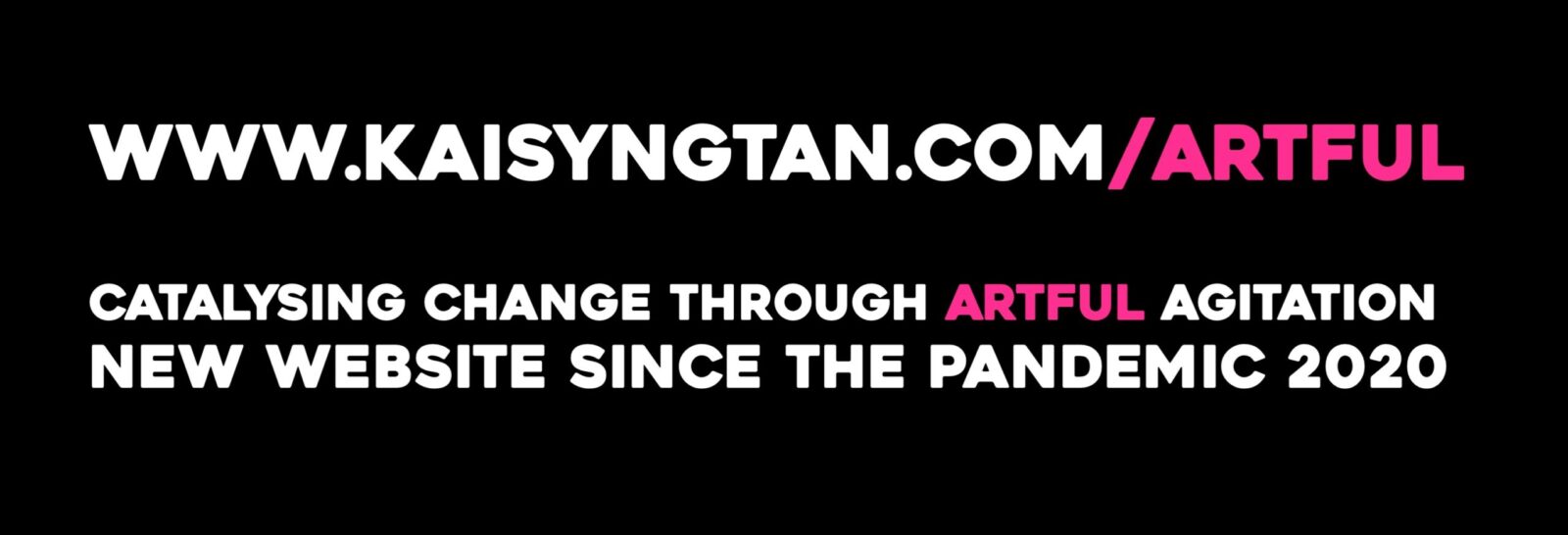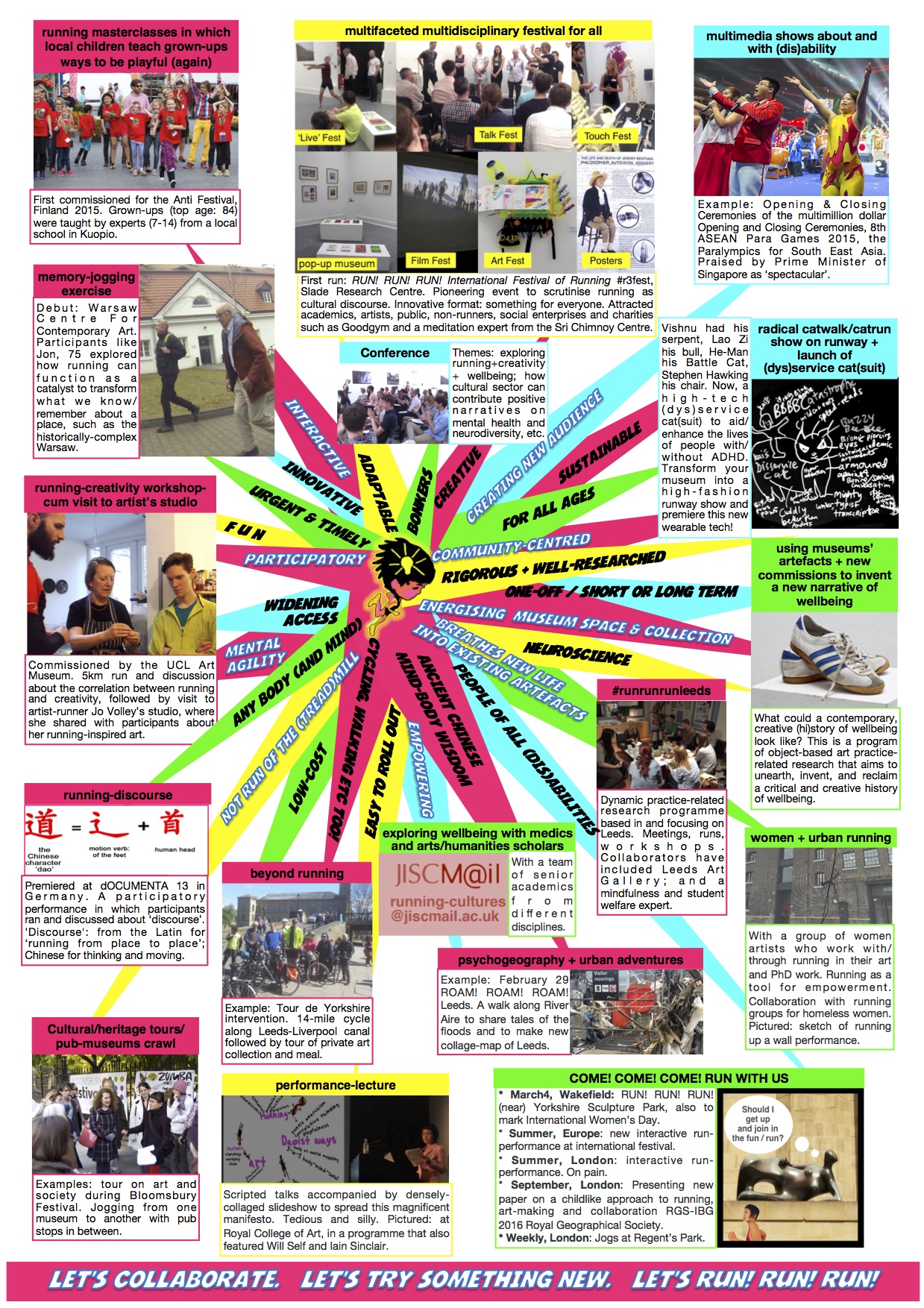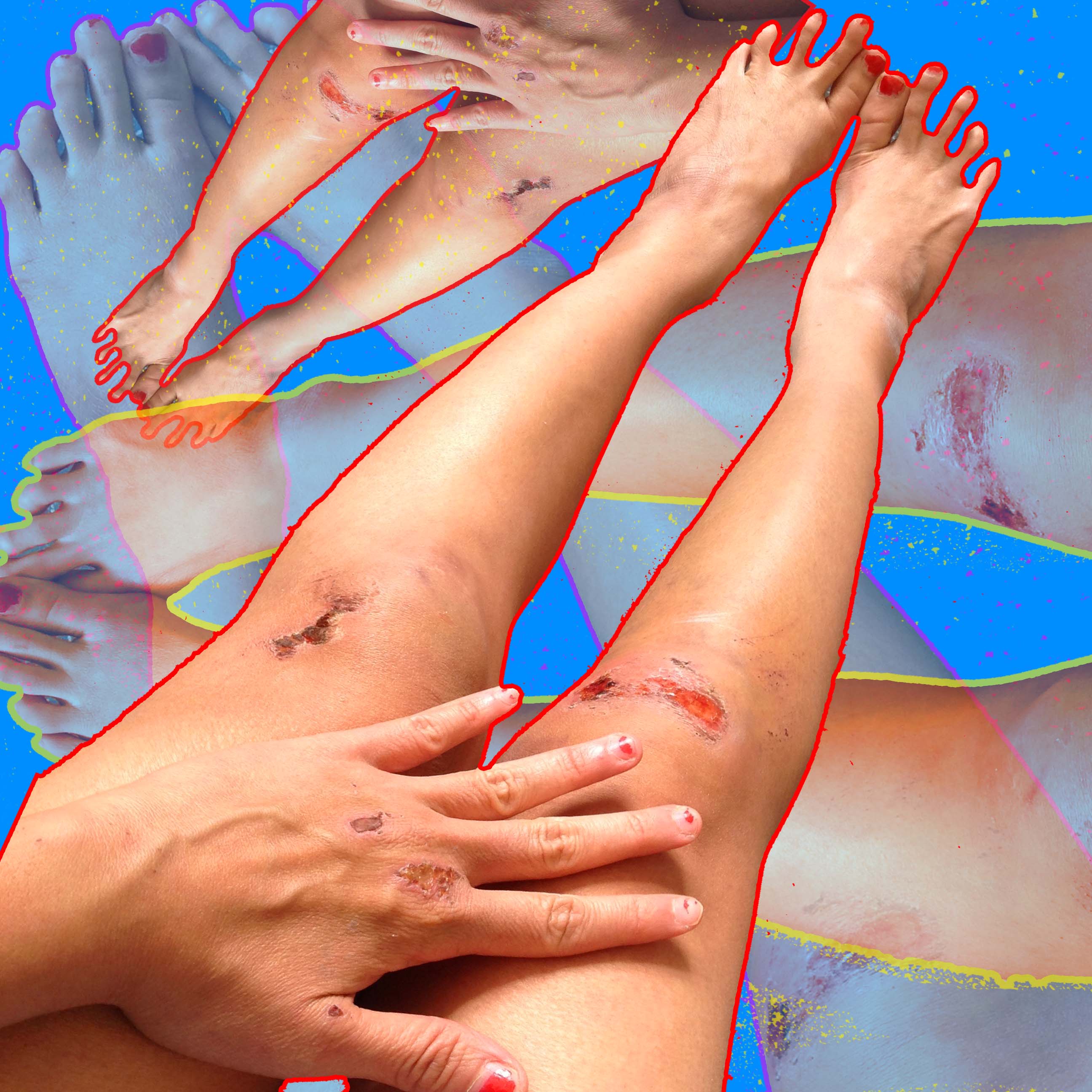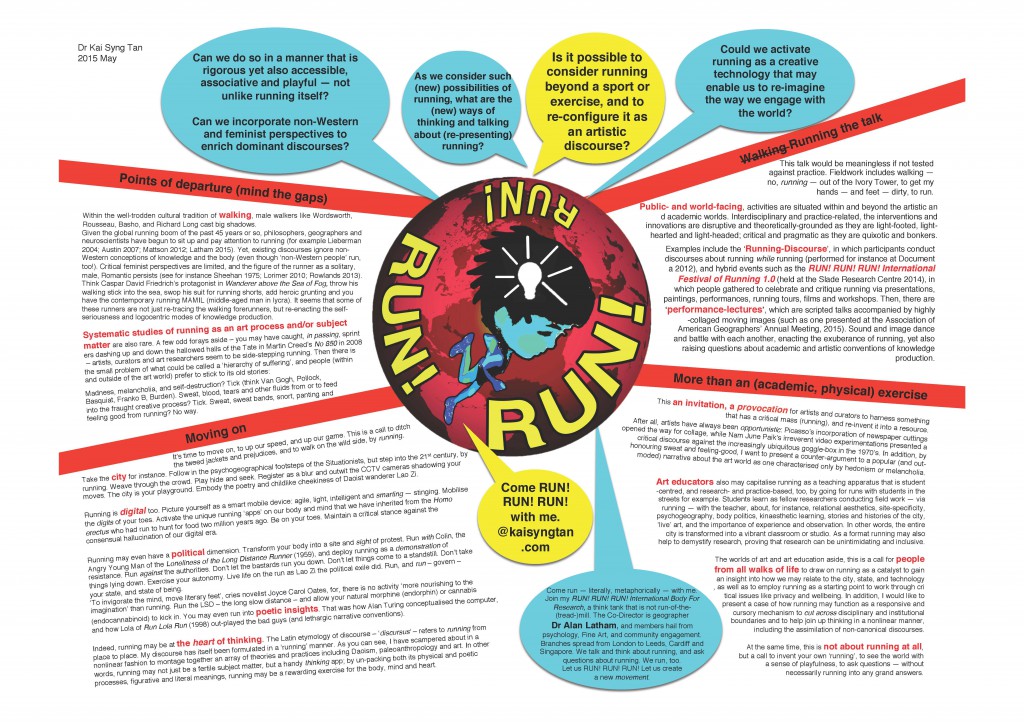RUN! RUN! RUN! International Body for Research #runrunrunart examines the ways in which the physical and poetic processes of the body and mind in motion (such as via running) could be reframed as a creative, critical and playful tools, and be mobilised as metaphor, methodology and material to open up new ways for the individual to (re-)engage with the self, others, the city and the world around us, and non-logocentric modes of thinking. Its interdisciplinary and practice-related research activities are rigorous as they are bonkers. RUN! RUN! RUN! is founded and run by artist/visual director Dr Kai Syng Tan FRSA to conduct solo and collaborative work. The Co-Director of RUN! RUN! RUN! is social scientist Dr Alan Latham (University College London). Participatory activities, interventions, installations, performance-lectures and films have been enjoyed at the Royal Geographical Society (UK), Royal Society of the Arts (UK), Documenta (Germany), Centre for Contemporary Arts (Warsaw), Association of American Geographers Annual Meeting (Chicago) and ANTI Festival (Kuopio), amongst others, and shortlisted for the Artangel Open 100, AHRC/BBC New Generation Thinkers, Great North Run Moving Images Commission, and Yinka Shinobare’s Guest Projects. Current and past collaborators, partner-institutions and friends hail from throughout the UK and the world including charities Goodgym, Free to Run, A Mile in Her Shoes and Headway East London; Philbeat/Philip Tan (Singapore), artists Dr Carali McCall (London/Canada) and Annie Grove-White (Cardiff), and academics Dr Andrew Filmer (Aberystwyth/Australia), Place Alliance (Bartlett, UCL), community engagement expert Richard Wright (Manchester/Canada), and the Running Cultures Research Group.
Artist Dr Kai Syng Tan FRSA founded the RUN! RUN! RUN! International Body for Research #runrunrunart, which she co-runs with social scientist Dr Alan Latham (UCL Geography). The research institute asks: What are the ways in which running can be activated as a critical, creative and playful technology, app or toolkit that may re-invigorate the way we engage with the city, the state and the digital world? How can running be mobilised to help cultivate an exuberant, non-linear, associative mode of thinking — rather like how many runners may think during the runner’s high? As we consider such (new) possibilities of running, what are the (new) ways of thinking, talking about and (re-)presenting running? Can we do so in a manner that is rigorous yet also accessible, associative and playful — not unlike running itself? Last but not least, what are the ways in which we can incorporate non-Western and feminist perspectives to enrich dominant discourses?
RUN! RUN! RUN! runs a wide repertoire of interdisciplinary, practice-related research activities. Situated within and beyond the artistic and academic worlds, these exercises are public- and world-facing, serious, rigorous and disruptive — as they are light-footed, light-hearted and bonkers. RUN! RUN! RUN! activities are enjoyed in the different parts of UK and the world. Of particular significance was the RUN! RUN! RUN! International Festival of Running 1.0 (Summer 2014, Slade Research Centre) which was a runaway success covered in the Guardian newspaper, and have since inspired and helped to kickstart other running-centred research efforts, as well as events and activities in the academic and arts sectors. Other RUN! RUN! RUN! activities were shortlisted in the Artangel Open 100 and Great North Run Moving Images Commission (2014), while different manifestations have been seen in more than 90 public events nationally and internationally since 2010, including dOCUMENTA (Kassel, Germany), Centre for Contemporary Arts (Warsaw, Poland), Association of American Geographers Annual Meeting (Chicago, USA) and Anti Festival (Kuopio, Finland). The branches of RUN! RUN! RUN! are in Leeds, London, Cardiff and Singapore, while Research Associates and Advisory Board members include senior academics and community experts.
Join us in this new movement, now. Follow the RUN! RUN! RUN! website. Take part in our hands-on, feet-on exercises. Follow us on twitter. Get in touch, email us.
[ppmaccordion][ppmtoggle title=”MORE“] RUN! RUN! RUN!: exaltation, invitation, provocation, celebration, interrogation, intervention, innovation, re-imagination, re-newal.
INTERNATIONAL: in roots, configuration, outlook; people, ideas, approach; public- and world-facing; engaging, experimenting & exploring together, partnerships, collaboration, knowledge-exchange, knowledge-creation, pushing borders, new worlds.
RESEARCH: cross-disciplinary, practice-related, hands-on, feet-on, rigorous, serious, bonkers, light-footed, light-hearted, playful, wanton, im-pure, diverse points of departure, multiple finishing lines, divergent possiblities.
BODY: doing, thinking, intuitive, intelligent, feeling, making, doing, em-bodied, acting, learning, teaching, training, creating, changing; an agency, an organisation, an action figure.
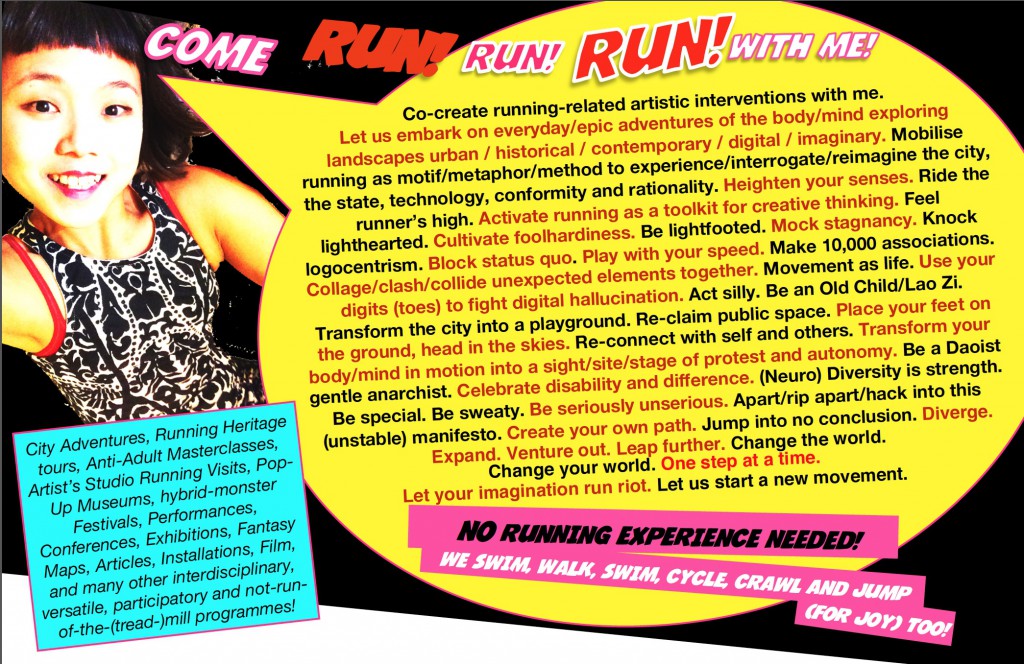 COME COME COME to RUN! RUN! RUN! with us, as audiences, participants, co-runners, collaborators, research-associates and partners-in-crime. The RUN! RUN! RUN! International Body for Research* investigates and promotes the ways in which running can be activated as a creative app that may enable us to re-imagine the way we engage with the world. This ethos itself is montaged by way of scampering through and picking and mixing a dizzying and delicious assortment of practices and theories including digital aesthetics, the ancient Chinese philosophy and practice of Daoism (Taoism), neuroscience, etymology and philosophy.
COME COME COME to RUN! RUN! RUN! with us, as audiences, participants, co-runners, collaborators, research-associates and partners-in-crime. The RUN! RUN! RUN! International Body for Research* investigates and promotes the ways in which running can be activated as a creative app that may enable us to re-imagine the way we engage with the world. This ethos itself is montaged by way of scampering through and picking and mixing a dizzying and delicious assortment of practices and theories including digital aesthetics, the ancient Chinese philosophy and practice of Daoism (Taoism), neuroscience, etymology and philosophy.
RUN! RUN! RUN! pulls together the work of a few of the ‘forerunners’ in the field of scholars and artists who study running as an arts and humanities subject. The research institute is founded and run by artist Dr Kai Syng Tan (Leeds College of Art). An artist with a 20-year international portfolio, Kai completed her PhD at the Slade School of Fine Art as a UCL Scholar. She has researched running since 2009 (and movement since 1994). The Co-Director is social scientist Dr Alan Latham (UCL Geography), who is a sub-3-hour marathon runner as well as a walking or rather running encyclopaedia of running. Alan has been studying running since 2007, and his work has been reported in the Independent.
RUN! RUN! RUN! runs a wide range of cross-disciplinary, practice-related research activities. Situated within and beyond the artistic and academic worlds, these exercises are public- and world-facing, serious, rigorous and disruptive — as they are light-footed, light-hearted, useless and plain bonkers. The first was the RUN! RUN! RUN! International Festival of Running 1.0 (Summer 2014, Slade Research Centre) which was a runaway success that was covered in the Guardian. Two projects were shortlisted in the Artangel Open 100 and Great North Run Moving Images Commission (2014), while different manifestations have been seen in more than 90 public events nationally and internationally since 2010. The branches of RUN! RUN! RUN! are in Leeds, London, Cardiff and Singapore, while Research Associates and Advisory Board members include senior academics and community experts.[/ppmtoggle][ppmtoggle title=”MORE MORE MORE“]
RUN! RUN! RUN! Let’s Create a New Movement.
Running: an artistic discourse?
What are the ways in which running can be activated as a critical, creative and playful technology, app or toolkit that may re-invigorate the way we engage with the city, the state and the digital world?
How can running be mobilised to help cultivate an exuberant, non-linear, associative mode of thinking — rather like how many runners may think during the runner’s high?
As we consider such (new) possibilities of running, what are the (new) ways of thinking, talking about and (re-)presenting running?
Can we do so in a manner that is rigorous yet also accessible, associative and playful — not unlike running itself?
What are the ways in which we can incorporate non-Western and feminist perspectives to enrich dominant discourses?
Points of departure
I am an artist, and I study running. More specifically, I ask questions – like the ones above – about running.
Where I come from, people have always preferred walking. Within the well-trodden cultural tradition, male walkers like Wordsworth, Rousseau, Basho, and Richard Long cast big shadows. With the global running boom of the past 45 years or so, philosophers, geographers and neuroscientists have begun to sit up and pay attention to running (for example Lieberman 2004; Austin 2007; Mattson 2012; Latham 2015). Yet, existing discourses ignore non-Western conceptions of knowledge and the body (even though ‘non-Western people’ run, too!). Critical feminist perspectives are limited, and the figure of the runner as a solitary, male, Romantic persists (see for instance Sheehan 1975; Lorimer 2010; Rowlands 2013). Think Caspar David Friedrich’s protagonist in Wanderer above the Sea of Fog, throw his walking stick into the sea, swop his suit for running shorts, add heroic grunting and you have a contemporary running MAMIL (middle-aged man in lycra). It seems that these runners are not just re-tracing the walking forerunners, but re-enacting the self-seriousness and logocentric modes of knowledge production. Systematic studies of running as an art process and/or subject matter are also rare. A few odd forays aside – you may have caught, in passing, sprinters dashing up and down the hallowed halls of the Tate in Martin Creed’s No 850 in 2008 – artists, curators and art researchers seem to be side-stepping running. Then there is the small problem of what I shall call a ‘hierarchy of suffering’, and people (within and outside of the art world) prefer to stick to its old stories. Madness, melancholia, and self-destruction? Tick (think Van Gogh, Pollock, Basquiat, Franko B, Burden). Sweat, blood, tears and other fluids from or to feed into the fraught creative process? Tick. Sweat, sweat bands, snort, panting and feeling good from running? No way..
Moving on
It’s time to move on, to up our speed, and up our game. This is a call to ditch the tweed jackets and prejudices, and to walk on the wild side, by running.
Take the city for instance. Follow in the psychogeographical footsteps of the Situationists, but step into the 21st century, by running. Weave through the crowd. Play hide and seek. Register as a blur and outwit the CCTV cameras shadowing your moves. The city is your playground. Embody the poetry and childlike cheekiness of Daoist wanderer Lao Zi.
Running is digital too. Picture yourself as a smart mobile device: agile, light, intelligent and smarting — stinging. Mobilise the digits of your toes. Activate the unique running ‘apps’ on our body and mind that we have inherited from the Homo erectus who had run to hunt for food two million years ago. Be on your toes. Maintain a critical stance against the consensual hallucination of our digital era.
Running may even have potential as a political tool. Transform your body into a site and sight of protest. Run with Colin, the Angry Young Man of the Loneliness of the Long Distance Runner (1959), and deploy running as a demonstration of resistance. Run against the authorities. Don’t let the bastards run you down. Don’t let things come to a standstill. Don’t take things lying down. Exercise your autonomy. Live life on the run as Lao Zi the political exile did. Run, and run – govern – your state, and state of being.
‘To invigorate the mind, move literary feet’, cries novelist Joyce Carol Oates, for, there is no activity ‘more nourishing to the imagination’ than running. Run the LSD – the long slow distance – and allow your natural morphine (endorphin) or cannabis (endocannabinoid) to kick in. You may even run into poetic insights. That was how Alan Turing conceptualised the computer, and how Lola of Run Lola Run (1998) out-played the bad guys (and lethargic narrative conventions).
Indeed, running may be at the heart of thinking. The Latin etymology of discourse – ‘discursus‘ – refers to running from place to place. My discourse has itself been formulated in a ‘running’ manner. As you can see, I have scampered about in a nonlinear fashion to montage together an array of theories and practices including Daoism, paleoanthropology and art. In other words, running may not just be a fertile subject matter, but a handy thinking app; by un-packing both its physical and poetic processes, figurative and literal meanings, running may be a rewarding exercise for the body, mind and heart.
Walking Running the talk
This talk about running would be meaningless if not tested against practice. Hence, fieldwork includes walking — no, running — out of the Ivory Tower, to get my hands — and feet — dirty, to run. Public- and world-facing, activities are situated within and beyond the artistic and academic worlds. Interdisciplinary and practice-related, the interventions and innovations are disruptive and theoretically-grounded as they are light-footed, light-hearted and light-headed; critical and pragmatic as they are quixotic and bonkers.
Examples include the ‘Running-Discourse’, in which participants conduct discourses about running while running (performed for instance at Documenta 2012), and hybrid events such as the RUN! RUN! RUN! International Festival of Running 1.0 (held at the Slade Research Centre 2014), in which people gathered to celebrate and critique running via presentations, paintings, performances, running tours, films and workshops. Then, there are ‘performance-lectures’, which are scripted talks accompanied by highly-collaged moving images (such as one presented at the Association of American Geographers’ Annual Meeting, 2015). Sound and image dance and battle with each another, enacting the exuberance of running, yet also raising questions about academic and artistic conventions of knowledge production.
More than an (academic, physical) exercise
This is an invitation, a provocation for artists and curators to harness something that has a critical mass (running), and re-invent it into a resource. After all, artists have always been opportunistic: Picasso’s incorporation of newspaper cuttings opened the way for collage, while Nam June Paik’s irreverent video experimentations presented a critical discourse against the increasingly ubiquitous goggle-box in the 1970’s. In addition, by honouring sweat and feeling-good, I want to present a counter-argument to a popular (and outmoded) narrative about the art world as one characterised only by hedonism or melancholia.
Art educators also may capitalise running as a teaching apparatus that is student-centred, and research- and practice-based, too, by going for runs with students in the streets for example. Students learn as fellow researchers conducting field work — via running — with the teacher, about, for instance, relational aesthetics, site-specificity, psychogeography, body politics, kinaesthetic learning, stories and histories of the city, ‘live’ art, and the importance of experience and observation. In other words, the entire city is transformed into a vibrant classroom or studio. As a format running may also help to demystify research, proving that research can be unintimidating and inclusive.
The worlds of art and art education aside, this is a call for people from all walks of life to draw on running as a catalyst to gain an insight into how we may relate to the city, state, and technology, as well as to employ running as a starting point to work through critical issues like privacy and wellbeing. In addition, I would like to present a case of how running may function as a responsive and cursory mechanism to cut across disciplinary and institutional boundaries and to help join up thinking in a nonlinear manner, including the assimilation of non-canonical discourses.
At the same time, this is not about running at all, but a call for us to invent our own ‘running’, to see the world with a sense of playfulness, to ask questions — without necessarily running into any grand answers.
Get on board!
Come run — literally, metaphorically — with me. Join my RUN! RUN! RUN! International Body For Research, a think tank that is not run-of-the-(tread-)mill. The Co-Director is geographer Dr Alan Latham, and members hail from psychology, Fine Art, and community engagement. Branches spread from London to Leeds, Cardiff and Singapore. We talk and think about running, and ask questions about running. We run, too.
Let us RUN! RUN! RUN! Let us create a new movement.
[/ppmtoggle][/ppmaccordion]
* The fine print: All ideas, images and text on this website belong to the RUN! RUN! RUN! International Body for Research. If you are inspired by our proposals and projects and wish to run the activities or have other suggestions, contact us and we would love to work with you. Any references made must credit RUN! RUN! RUN! International Body for Research, and include a link it to this website, kaisyngtan.com.
